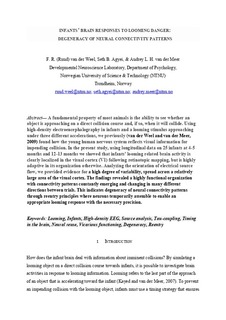| dc.contributor.author | Van der Weel, Frederikus | |
| dc.contributor.author | Agyei, Seth Bonsu | |
| dc.contributor.author | Van der Meer, Audrey | |
| dc.date.accessioned | 2019-09-23T10:46:44Z | |
| dc.date.available | 2019-09-23T10:46:44Z | |
| dc.date.created | 2019-01-30T08:55:18Z | |
| dc.date.issued | 2019 | |
| dc.identifier.citation | Ecological psychology. 2019, 31 (3), 182-197. | nb_NO |
| dc.identifier.issn | 1040-7413 | |
| dc.identifier.uri | http://hdl.handle.net/11250/2618207 | |
| dc.description.abstract | A fundamental property of most animals is the ability to see whether an object is approaching on a direct collision course and, if so, when it will collide. Using high-density electroencephalography in infants and a looming stimulus approaching under three different accelerations, we previously found how visual information for impending collision is sustained in the young human nervous system. In the present study, using longitudinal data on 25 infants at 4–5 months and 12–13 months, we show that infants’ looming-related brain activity is clearly localized in the visual cortex (V1) following retinotopic mapping, but is highly adaptive in its organization otherwise. Analyzing the orientation of electrical source flow, we provide evidence for a high degree of variability, spread across a relatively large area of the visual cortex. The findings reveal a highly dynamic functional organization, with connectivity patterns constantly emerging and changing in many different directions between trials. This suggests degeneracy of neural connectivity patterns through reentry principles, where neurons temporarily assemble to enable an appropriate looming response with the necessary precision. | nb_NO |
| dc.language.iso | eng | nb_NO |
| dc.publisher | Taylor & Francis | nb_NO |
| dc.title | Infants' brain responses to looming danger: Degeneracy of neural connectivity patterns | nb_NO |
| dc.type | Journal article | nb_NO |
| dc.type | Peer reviewed | nb_NO |
| dc.description.version | acceptedVersion | nb_NO |
| dc.source.pagenumber | 182-197 | nb_NO |
| dc.source.volume | 31 | nb_NO |
| dc.source.journal | Ecological psychology | nb_NO |
| dc.source.issue | 3 | nb_NO |
| dc.identifier.doi | 10.1080/10407413.2019.1615210 | |
| dc.identifier.cristin | 1668240 | |
| dc.description.localcode | Locked until 11.7.2020 due to copyright restrictions. This is an [Accepted Manuscript] of an article published by Taylor & Francis in [Ecological psychology] on [11 Jul 2019], available at https://doi.org/10.1080/10407413.2019.1615210 | nb_NO |
| cristin.unitcode | 194,67,40,0 | |
| cristin.unitname | Institutt for psykologi | |
| cristin.ispublished | true | |
| cristin.fulltext | original | |
| cristin.qualitycode | 1 | |
